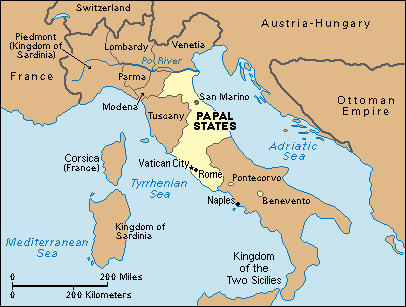Papal States was the name given to territory once ruled by the pope of the Roman Catholic Church. The pope exercised temporal (economic, military, and political) control over the Papal States. Most of the states were located in central Italy, with some lands in France for a time. Today, the pope has temporal control only over the 109 acres (44 hectares) of Vatican City, an independent country within the boundaries of Rome.

The Papal States originated in 756 with land that Pepin the Short, king of the Franks, gave to Pope Stephen II. The Papal States began to grow during the reign of Saint Leo IX in the mid-1000’s. The states expanded the most in the 1200’s, particularly under the leadership of Pope Innocent III. The Papal States declined in political and economic strength during the 1600’s and 1700’s.
In 1809, Emperor Napoleon I of France annexed the Papal States and made Pope Pius VII a prisoner. After Napoleon’s defeat, the Congress of Vienna restored most of the states to the pope in 1815. However, the return was temporary. Residents of the Papal States revolted against papal control in 1831, in 1848 and 1849, and again in 1860. During the revolt of 1860, Victor Emmanuel II conquered central Italy, and in 1861 he declared the formation of the Kingdom of Italy. Victor Emmanuel became its first king. Only the land immediately surrounding Rome remained under the control of the church. The establishment of the Kingdom of Italy began a period of political and religious conflict between the popes and the Italian government known as the Roman Question.
In 1870, French forces stationed in Rome withdrew, and Victor Emmanuel captured the city. He asked Roman citizens whether the city should become the political capital of a united Italy. The people voted for unification, thus effectively ending the Papal States as a distinct church-controlled territory. Pope Pius IX shut himself up in the Vatican in protest and referred to himself as a prisoner.
The Roman Question was finally resolved in 1929. In that year, an independent Vatican City state was established through an agreement called the Lateran Treaty. The treaty was made between Pope Pius XI and the Italian government. Under its terms, all financial claims between the two sides were settled, with Italy presenting a payment of cash and bonds to the church. The papacy, in effect, gave up its claims to the territory of the Papal States. Vatican City was to be fully independent. The church was to have exclusive jurisdiction within its boundaries, and the territory was always to be considered neutral and inviolable. In a separate concordat (agreement) signed at the same time, the Italian government accepted both the church’s status as the official state religion and the church’s jurisdiction in Italy over such matters as marriage and divorce.
In 1984, the Italian government and the Vatican ratified a revised version of the concordat. The revised version retained the independence of Vatican City but ended other church privileges, including the church’s status as the state-supported religion in Italy.
